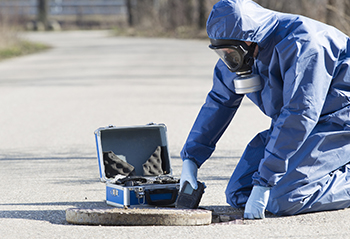OSHA HAZWOPER Site Characterization
Site Characterization & Analysis
The Occupational Safety and Health Administration (OSHA), outlines employer compliance requirements regarding Hazardous Waste Operations & Emergency Response (HAZWOPER) contained within 29CFR 1910.120.
One of the most critical initial steps in that standard is Site Characterization & Analysis, specifically outlined in 1910.120(c). As no two hazardous waste sites are exactly alike, a site must first be carefully analyzed to identify the specific hazards and select the appropriate worker protection and control methods before any work commences.
OSHA makes it clear this site characterization shall be performed only by a qualified person. And as a reminder, OSHA defines a qualified person within the HAZWOPER standard as a person with specific training, knowledge and experience in the area for which the person has the responsibility and the authority to control.
That qualified person is and should often be assisted in this process by various other subject matter experts such as such as chemists, health physicists, industrial hygienists, and toxicologists. Most hazardous waste sites require extensive research regarding the site characteristics and its specific hazards as often there is little to no accurate documented history to go by.
Hazardous waste sites shall be evaluated to identify specific site hazards and to determine the appropriate safety and health control procedures needed to protect employees from the identified hazards through a preliminary evaluation to include both an on and off-site approach. Here’s more on that from the standard.
Preliminary Evaluations.
An off-site preliminary evaluation shall be performed prior to site entry by a qualified person in order to aid in the selection of appropriate employee protection methods prior to site entry. Immediately after initial site entry, a more detailed on-site evaluation of the site's specific characteristics shall be performed by a qualified person in order to further identify existing site hazards and to further aid in the selection of the appropriate engineering controls and personal protective equipment for the tasks to be performed. All suspected conditions that may pose inhalation or skin absorption hazards that are Immediately Dangerous to Life or Health (IDLH) or other conditions that may cause death or serious harm shall be identified and evaluated.
And remember, the safety and health of the individuals performing these preliminary on-site evaluations is critical. As such, all Personal Protective Equipment requirements set forth in section 1910.120(c)(5) as well as Appendix B of the standard shall be carefully followed.
Required information.
So, what type of required information shall be gathered during these preliminary evaluations?
The following preliminary evaluation information to the extent available shall be obtained by the employer prior to allowing employees to enter a site:
- Location and approximate size of the site.
- Description of the response activity and/or the job task to be performed.
- Duration of the planned employee activity.
- Site topography and accessibility by air and roads.
- Safety and health hazards expected at the site.
- Pathways for hazardous substance dispersion.
- Present status and capabilities of emergency response teams that would provide assistance to on-site employees at the time of an emergency.
- Hazardous substances and health hazards involved or expected at the site and their chemical and physical properties.
Monitoring.
Once employees have been allowed to enter a site, there may be requirements for ongoing monitoring. The following monitoring shall be conducted during initial site entry when the site evaluation produces information which shows the potential for ionizing radiation or IDLH conditions, or when the site information is not sufficient reasonably to eliminate these possible conditions:
- Monitoring with direct reading instruments for hazardous levels of ionizing radiation.
- Monitoring the air with appropriate direct reading test equipment for (i.e., combustible gas meters, detector tubes) for IDLH and other conditions that may cause death or serious harm (combustible or explosive atmospheres, oxygen deficiency, toxic substances.)
- Visually observing for signs of actual or potential IDLH or other dangerous conditions.
- An ongoing air monitoring program shall be implemented after site characterization has determined the site is safe for the start-up of operations.
Risk identification.
Once the presence and concentrations of specific hazardous substances and health hazards have been established, the risks associated with these substances shall be identified. Employees who will be working on the site shall be informed of any risks that have been identified. In situations covered by the Hazard Communication Standard (HCS), 29 CFR 1910.1200, training required by that standard need not be duplicated. Risks to consider include, but are not limited to:
- Exposures exceeding the permissible exposure limits and published exposure levels.
- IDLH concentrations.
- Potential skin absorption and irritation sources.
- Potential eye irritation sources.
- Explosion sensitivity and flammability ranges.
- Oxygen deficiency.
As the old saying goes, “Every battle is won or lost before it’s ever fought”. Thorough Site Characterization & Analysis is a critical compliance requirement of the OSHA HAZWOPER Standard.
For more information, OSHA has published an informative HAZWOPER Safety & Health Topic site.

